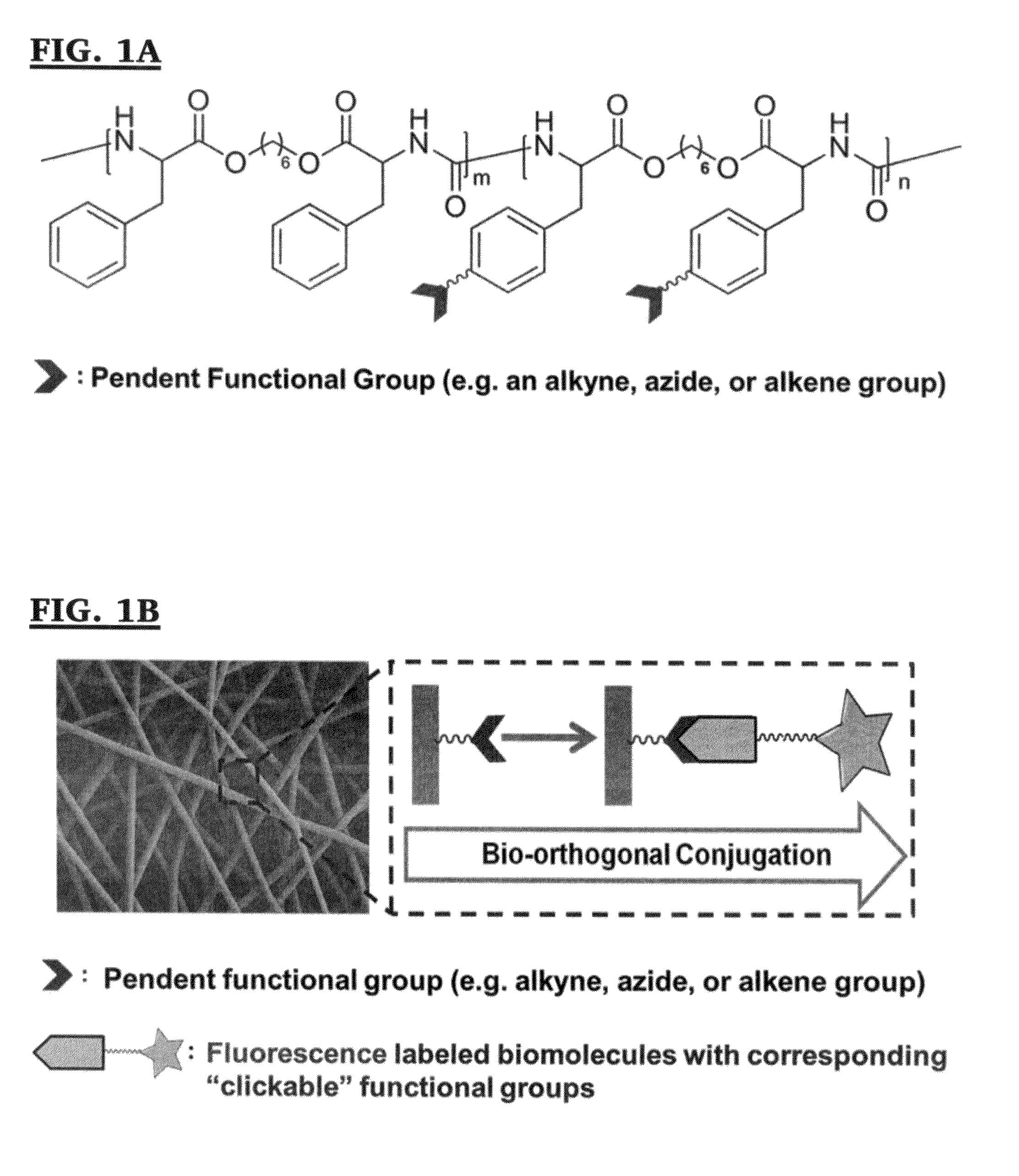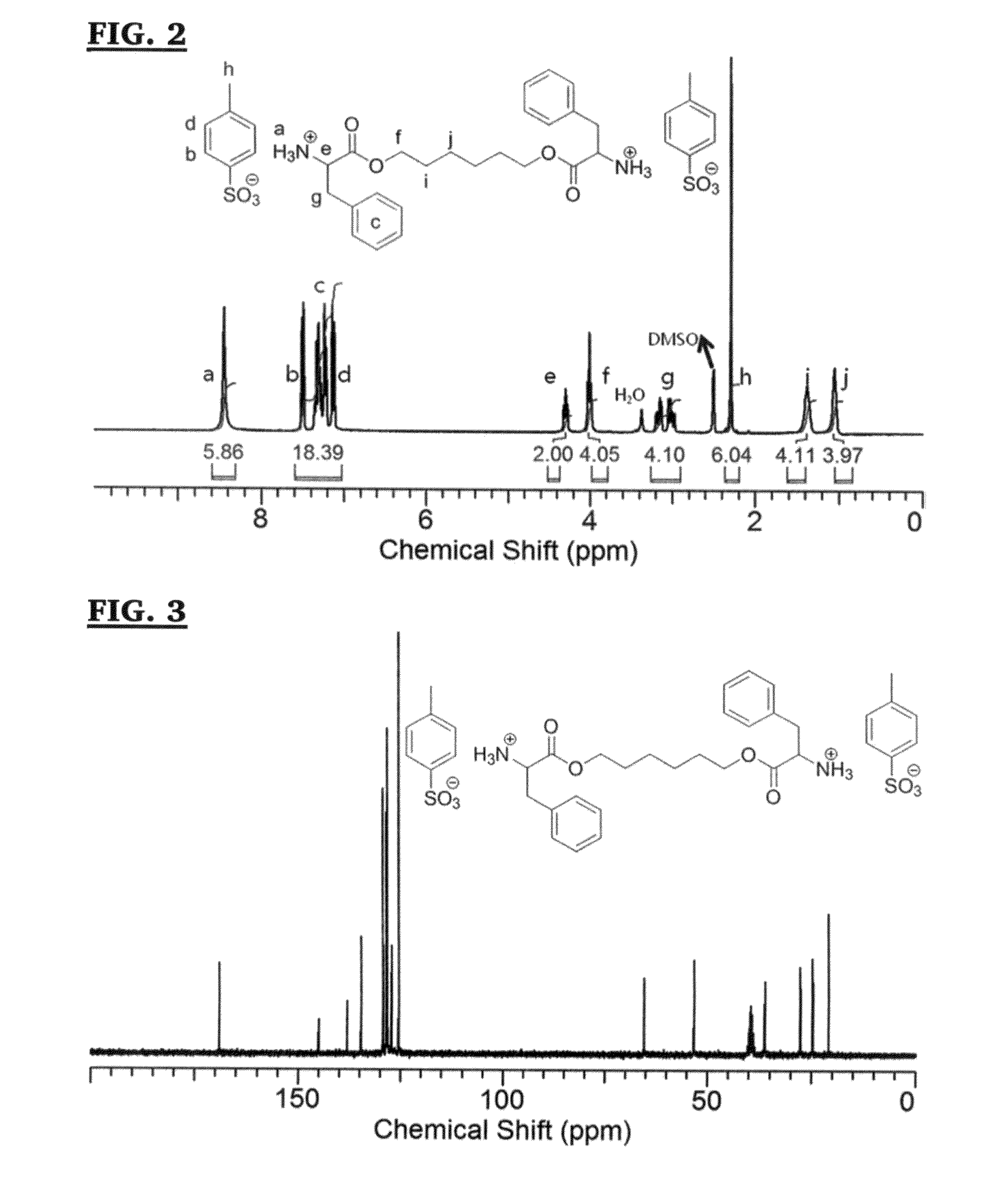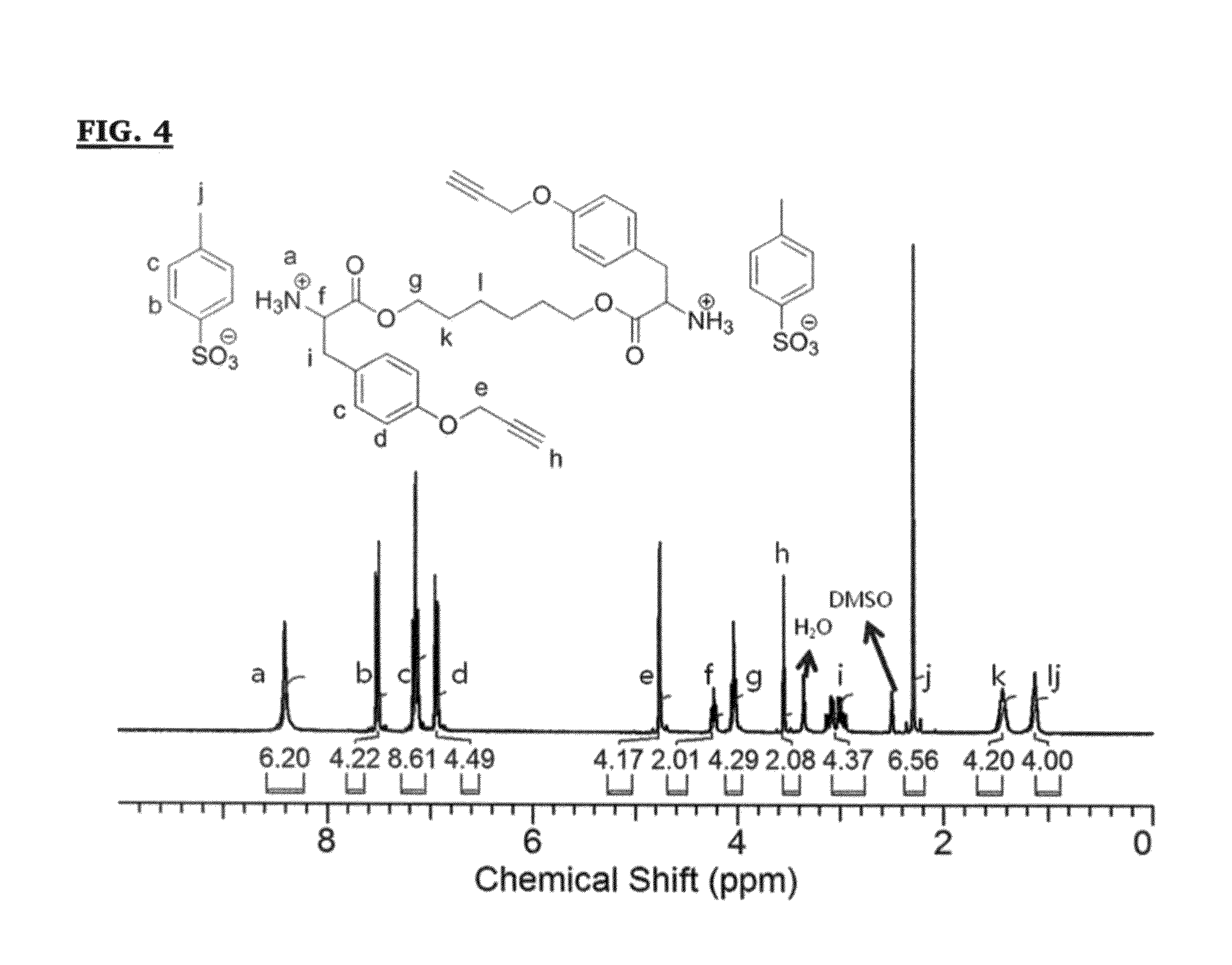Methods for post-fabrication functionalization of poly(ester ureas)
a functionalization and polymer technology, applied in the field of functionalized poly (ester urea), can solve the problems of difficult isolation, derivatization and purification, limited physical and chemical properties, and general difficulty in attaching bioactive molecules like peptides or proteins prior to processing
- Summary
- Abstract
- Description
- Claims
- Application Information
AI Technical Summary
Benefits of technology
Problems solved by technology
Method used
Image
Examples
example 1
Synthesis of Monomer of PEU-1 (M1)
[0197]The route used to synthesize the L-phenylalanine based monomer (M1) (for making PEU-1) is described in Scheme 4, and is reported in Stakleff, K. S.; Lin, F.; Smith Callahan, L. A.; Wade, M. B.; Esterle, A.; Miller, J.; Graham, M.; Becker, M. L. Acta Biomaterialia 2013, 9, 5132, the disclosure of which is encorporated herein by reference in its entirety.
[0198]Scheme 4 shows the condensation of the L phenylalanine with the diol (in this case 1,6 hexane diol) to form compound (XLV) (M1). The TsOH acidifys the solution conditions preventing the amidation of the carboxylic acids. The protonated amino acid components was then heated at reflux at 110° C. in toluene to form the ester compounds. The Dean Stark trap was used to collect the water biproducts, increasing the yield of the reaction.
[0199]1H NMR (300 MHz, DMSO-d6): δ=8.45 (br, 6H, +NH3—), 7.00-7.53 (m, 18H, aromatic), 4.30 (t, 2H, +NH3CHCOO—), 4.00 (t, 4H, —COOCH2CH2—), 2.90-3.25 (m, 4H, —CHC...
example 2
Synthesis of Monomer of PEU-2 (M2)
[0200]The synthesis of alkyne-monomer (M2) for making PEU-2 was similar to the synthesis process of compound X (M1), except o-propargyltyrosine was used instead of L-phenylalanine. See Deiters, A.; Cropp, T. A.; Mukherji, M.; Chin, J. W.; Anderson, J. C.; Schultz, P. G. Journal of the American Chemical Society 2003, 125, 11782, the disclosure of which is encorporated herein by reference. The chemical formula for M2 is shown below.
[0201]Compound XIV (M2) was purified by recrystallization with a mixture of water and ethanol (5:1, v / v) four times. The product came out as a white powder (yield 75%). 1H NMR (300 MHz, DMSO-d6): δ=8.41 (s, 6H, +NH3—), 7.50 (d, 4H, aromatic), 7.10-7.20 (m, 8H, aromatic), 6.95 (d, 4H, aromatic), 4.76 (d, 4H, —OCH2C≡CH), 4.23 (t, 2H, +NH3CHCOO—), 4.04 (t, 4H, —COOCH2CH2—), 3.55 (t, 2H, —OCH2C≡CH), 2.90-3.25 (m, 4H, —CHCH2—Ar), 2.29 (s, 6H, CH3Ar—), 1.25-1.50 (br, 4H, —COOCH2CH2CH2—), 0.95-1.15 (br, 4H, —COOCH2CH2CH2—). See FI...
example 3
Synthesis of Monomer of PEU-3 (M3)
[0202]The synthesis route for the azide-monomer used to make for PEU-3 (compound XV) (M3) is shown in Scheme 5, below. It was similar to that of S6 (M4), except that 3-azidopropyl 4-methylbenzenesulfonate was used instead of 5-Bromo-1-pentene. See, Mantovani, G.; Ladmiral, V.; Tao, L.; Haddleton, D. M. Chemical Communications 2005, 2089, the disclosure of which is hereby encorprated by reference.
[0203]Compound XLVI was prepared by base catalyzed substitution of the Tosyl protected alkyl azide. The Boc and methyl ester protected tyrosine as dissolved in N,N-dimethylformamide and the tosyl protected alkyl azide was added in a stoichiometric ration. Potassium carbonate was added as a base and the reaction mixture was heated at 80 C for 24 hours under a blanket of inert gas. Compound XLVI: 1H NMR (300 MHz, CDCl3): δ=6.95-7.15 (m, 2H), 6.75-6.90 (m, 2H), 4.96 (d, 1H), 4.45-4.65 (m, 1H), 4.03 (t, 2H), 3.52 (t, 2H), 2.95-3.12 (m, 2H), 1.97-2.10 (2H), 1.43 ...
PUM
| Property | Measurement | Unit |
|---|---|---|
| temperature | aaaaa | aaaaa |
| pressure | aaaaa | aaaaa |
| temperature | aaaaa | aaaaa |
Abstract
Description
Claims
Application Information
 Login to View More
Login to View More - R&D
- Intellectual Property
- Life Sciences
- Materials
- Tech Scout
- Unparalleled Data Quality
- Higher Quality Content
- 60% Fewer Hallucinations
Browse by: Latest US Patents, China's latest patents, Technical Efficacy Thesaurus, Application Domain, Technology Topic, Popular Technical Reports.
© 2025 PatSnap. All rights reserved.Legal|Privacy policy|Modern Slavery Act Transparency Statement|Sitemap|About US| Contact US: help@patsnap.com



